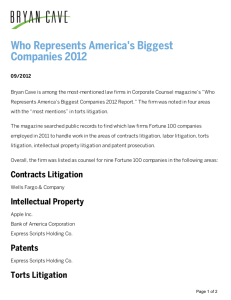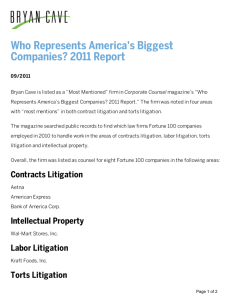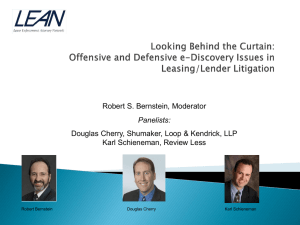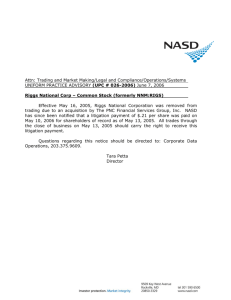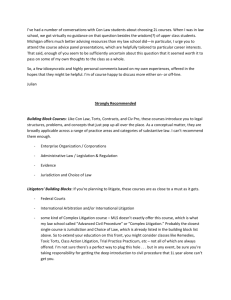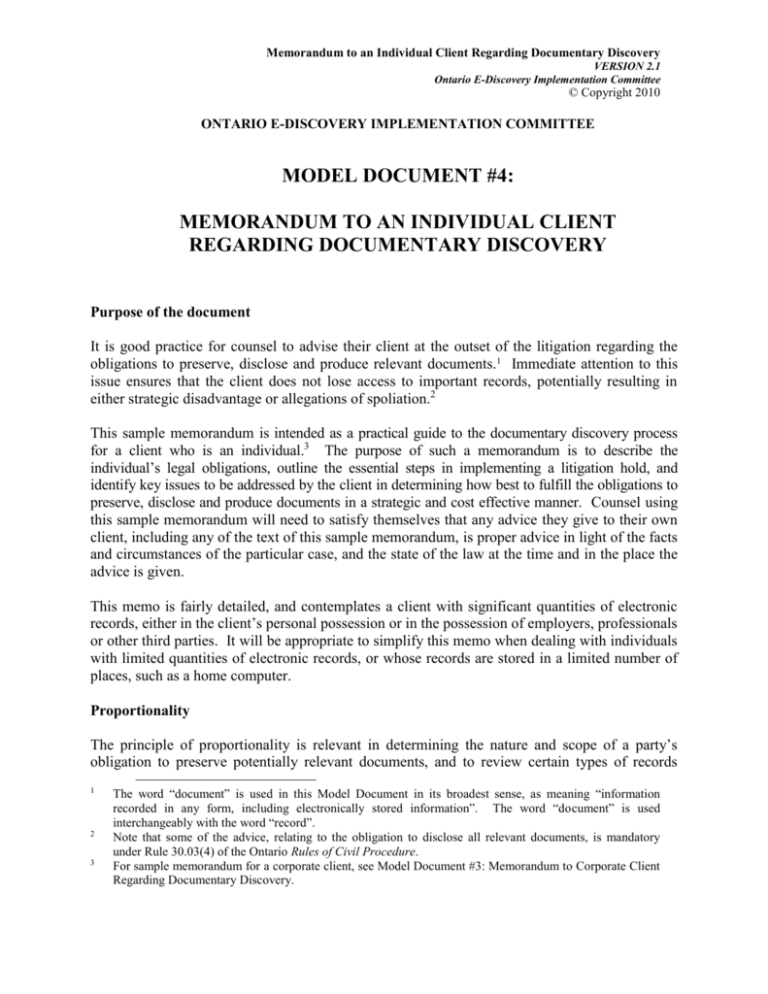
Memorandum to an Individual Client Regarding Documentary Discovery
VERSION 2.1
Ontario E-Discovery Implementation Committee
© Copyright 2010
ONTARIO E-DISCOVERY IMPLEMENTATION COMMITTEE
MODEL DOCUMENT #4:
MEMORANDUM TO AN INDIVIDUAL CLIENT
REGARDING DOCUMENTARY DISCOVERY
Purpose of the document
It is good practice for counsel to advise their client at the outset of the litigation regarding the
obligations to preserve, disclose and produce relevant documents.1 Immediate attention to this
issue ensures that the client does not lose access to important records, potentially resulting in
either strategic disadvantage or allegations of spoliation.2
This sample memorandum is intended as a practical guide to the documentary discovery process
for a client who is an individual.3 The purpose of such a memorandum is to describe the
individual’s legal obligations, outline the essential steps in implementing a litigation hold, and
identify key issues to be addressed by the client in determining how best to fulfill the obligations to
preserve, disclose and produce documents in a strategic and cost effective manner. Counsel using
this sample memorandum will need to satisfy themselves that any advice they give to their own
client, including any of the text of this sample memorandum, is proper advice in light of the facts
and circumstances of the particular case, and the state of the law at the time and in the place the
advice is given.
This memo is fairly detailed, and contemplates a client with significant quantities of electronic
records, either in the client’s personal possession or in the possession of employers, professionals
or other third parties. It will be appropriate to simplify this memo when dealing with individuals
with limited quantities of electronic records, or whose records are stored in a limited number of
places, such as a home computer.
Proportionality
The principle of proportionality is relevant in determining the nature and scope of a party’s
obligation to preserve potentially relevant documents, and to review certain types of records
1
2
3
The word “document” is used in this Model Document in its broadest sense, as meaning “information
recorded in any form, including electronically stored information”. The word “document” is used
interchangeably with the word “record”.
Note that some of the advice, relating to the obligation to disclose all relevant documents, is mandatory
under Rule 30.03(4) of the Ontario Rules of Civil Procedure.
For sample memorandum for a corporate client, see Model Document #3: Memorandum to Corporate Client
Regarding Documentary Discovery.
2
Memorandum to an Individual Client Regarding Documentary Discovery
VERSION 2.1
Ontario E-Discovery Implementation Committee
© Copyright 2010
(e.g., backup media, deleted electronic files, etc.) for relevance. The issue arises primarily in the
context of electronically stored information, although it can be relevant to traditional paper
documents in some circumstances.
The parties should ensure that all steps taken in the discovery process are proportionate, taking
into account, among other things, the importance and complexity of the case, the amounts and
interests at stake, and the costs, delay, burden and benefit associated with each step. In some
cases, particularly those involving a small dollar value or uncomplicated facts, it may not be
appropriate to require that costly steps be taken to preserve and review all potentially relevant
records, where the likelihood of unique or important documents being found is low or unknown.
In advising a client on what steps must be taken in order to satisfy the client’s legal obligations
and to avoid allegations of spoliation, counsel must seek to strike an appropriate balance.4
With respect to preservation of relevant documents, this sample memorandum is meant to
address the principal preservation issues that could arise in a civil litigation matter. In most
cases, certain issues addressed in this memorandum will not arise. For example, in the majority
of cases it will likely not be necessary for the client to restore backup media (if the client
maintains backup media). The memorandum directs the client to discuss with their counsel a
number of possible preservation issues. It will be up to counsel, taking into account the
circumstances of the case and the principle of proportionality, to determine what steps are
appropriate and to advise the client accordingly.
One of the most effective means of protecting both the client and counsel from allegations that
inadequate preservation efforts were made is for the parties to reach agreement on required
preservation steps, whether at a “meet and confer” session or otherwise.5
Annotations
Annotations are included at various points throughout the model document, identifying issues
that counsel may wish to consider in advising their client. Many of the annotations refer to The
Sedona Canada Principles Addressing Electronic Discovery (the “Sedona Canada Principles”).
Civil litigants in Ontario are required, pursuant to Rule 29.1 of the Rules of Civil Procedure, to
4
5
Principle #2 of the Sedona Canada Principles states that “In any proceeding, the parties should ensure that
steps taken in the discovery process are proportionate, taking into account (i) the nature and scope of the
litigation, including the importance and complexity of the issues, interest and amounts at stake; (ii) the
relevance of the available electronically stored information; (iii) its importance to the court’s adjudication in
a given case; and (iv) the costs, burden and delay that may be imposed on the parties to deal with
electronically stored information.” Principle #2 is explicitly reflected in the following Rules of Civil
Procedure in Ontario: rules 1.04(1.1), 20.05(2), 29.1, and 29.2.
Principle #4 of the Sedona Canada Principles states that “Counsel and parties should meet and confer as
soon as practicable and on an ongoing basis, regarding the identification, preservation, collection, review
and production of electronically stored information.” In this regard, see Model Document #1: Discovery
Agreement, Model Document #2: Preservation Agreement, Model Document #9A: Discovery Plan (Long
Form), Model Document #9B: Discovery Plan (Short Form) and Sample Document #1: Letter Confirming
Discovery Agreement.
3
Memorandum to an Individual Client Regarding Documentary Discovery
VERSION 2.1
Ontario E-Discovery Implementation Committee
© Copyright 2010
consult and have regard to the Sedona Canada Principles in preparing a discovery plan for an
action. The Sedona Canada Principles are a set of national guidelines for e-discovery in
Canada, which reflect both existing legal principles and a set of identified best practices. A copy
of the Sedona Canada Principles may be downloaded from www.thesedonaconference.org,
where they are found under the list of publications for Working Group 7.
The annotations are included for the benefit of counsel, who will presumably wish to delete the
annotations, or to incorporate parts of them into the text of the letter, prior to sending the
memorandum to the client.
Note regarding use of this document
This memorandum and all of the EIC’s model documents and other publications are available
on the Ontario Bar Association's website at:
http://www.oba.org/En/publicaffairs_en/E-Discovery/model_precedents.aspx
This model document has been prepared and made available to the public by the EIC for
informational purposes. It is not provided as legal or technical advice and should not be relied
upon as such.
Publications of the EIC are copyrighted by the Ontario E-Discovery Implementation
Committee and all rights are reserved. Individuals may download these publications for their
own use at no charge. Law firms and other organizations may download these publications
and make them available internally for individual use within the firm or organization. EIC
publications may be republished, copied or reprinted at no charge for non-profit purposes.
Organizations and individuals may provide a link to the publications on the internet without
charge provided that proper attribution to the Ontario E-Discovery Implementation
Committee is included. For further information, or to request permission to republish, copy or
reprint for commercial profit, contact the Chair of the Committee, David Outerbridge, at
douterbridge@torys.com.
Feedback on EIC materials
The EIC welcomes comments on all of its model documents and other publications. Any
comments or suggestions can be provided to Michele A. Wright at mwright4@toronto.ca.
Memorandum to an Individual Client Regarding Documentary Discovery
VERSION 2.1
Ontario E-Discovery Implementation Committee
© Copyright 2010
MEMORANDUM
Privileged and Confidential
TO:
[Name of client]
FROM:
[Name of lawyer/firm]
SUBJECT:
[Case Name]
I.
DDATE:
Preservation, disclosure and production of documents
PURPOSE OF THIS MEMORANDUM
The purpose of this memorandum is to:
(a)
describe your legal obligations with respect to potential documentary evidence in
this litigation;
(b)
outline the essential steps in implementing a litigation hold in order to preserve
potentially relevant documents; and
(c)
identify key issues in fulfilling the obligations to preserve, disclose and produce
documents in a strategic, proportionate and cost effective manner.
A guiding principle in the documentary discovery process is proportionality. The approach to
preserving, disclosing and producing documents must be proportionate, taking into account, among
other things, the importance and complexity of the case, the amounts and interests at stake, and
the costs, delay, burden and benefit associated with each step.
The goal of this memorandum is to help you to navigate through the documentary discovery process
efficiently and without undue burden, but also effectively, in a manner that is strategically optimal
and that satisfies all of your legal obligations.
Section II of the memo provides an overview of key strategic issues.
Sections III, IV and V provide a detailed review of how the discovery process should be
implemented in order to meet your obligations in an effective and proportionate manner. Note that
some of the tasks discussed in this detailed review may not be required in this litigation, depending
5
upon a number of factors that we can discuss with you.6
II.
OVERVIEW OF KEY ISSUES
Three obligations: The existence of litigation (or reasonably anticipated litigation) creates unique
obligations for you with respect to your documents7, both paper and electronic. There are three
discrete obligations:
(a)
the obligation to preserve potentially relevant documents;
(b)
the obligation to disclose all relevant documents in an affidavit of documents; and
(c)
the obligation to produce copies of relevant documents that are not privileged.
E-Discovery: Documentary discovery involves disclosing and producing not only paper documents
but also electronically stored information. In today’s technological environment, most documents
are electronically stored, and thus the discovery of these records (known as “e-discovery”) has taken
on an added importance. Although the basic rules of discovery are the same whether a record is
paper or electronic, the nature of electronic records is such that they raise a number of unique
preservation and production issues, which are addressed in this memorandum.
Risk of spoliation sanctions: In making decisions on documentary discovery issues, it is
important to consider the risks involved in not taking early and effective action. Where potentially
relevant documents are destroyed or lost rather than being preserved, you may face allegations of
spoliation of evidence. The consequences of spoliation can be very serious. The court may dismiss
a claim or strike a defence, it may draw an adverse inference from the destruction of the documents,
or it may require payment of some of the opposing parties’ costs, among other things.8 It is
reasonable to expect such sanctions to be applied in Ontario in an appropriate case.
Benefits of early and effective discovery: It is generally more cost effective on a net basis to take a
thorough approach to locating and collecting potentially relevant documents at the outset of the
litigation. Usually, too, it is to your strategic advantage to locate and review all potentially relevant
documents as soon as possible.
Proportionality: A guiding principle in the documentary discovery process is proportionality, taking
into account, among other things, the importance and complexity of the case, the amounts and
interests at stake, and the costs, delay, burden and benefit associated with each step.
6
7
8
If counsel knows at the time of sending a memorandum to the client that some of the tasks identified in the
memorandum need not be undertaken, the memorandum can be revised accordingly.
The term “document” as used in the civil litigation process is defined very broadly, as explained below in
Section III.B.
Principle #11 of the Sedona Canada Principles states in part that “Sanctions should be considered by the
court where a party will be materially prejudiced by another party’s failure to meet any obligation to
preserve, collect, review or produce electronically stored information. The party in default may avoid
sanctions if it demonstrates the failure was not intentional or reckless.” Comment 11.a states that “[t]he role
of the court is to weigh the scope and impact of non-disclosure and to impose appropriate sanctions
proportional to the culpability of the non-producing party, the prejudice to the opposing litigant and the
impact that the loss of evidence may have on the court’s ability to fairly dispose of the issues in dispute.”
6
In some cases, it is not appropriate to require that costly steps be taken to preserve and review all
potentially relevant records, where the likelihood of important documents being found is low or
unknown. In other cases, a more intensive documentary discovery process will be required.
Judgment calls may need to be made. The documentary discovery process may require you to make
difficult decisions that involve weighing the costs and benefits of pursuing a more exhaustive
approach to discovery.9 One purpose of this memorandum is to identify the issues that require
discussion and strategic decision making.
Importance of case-specific analysis: Every litigation matter is different, and raises unique
considerations. We will discuss with you the approach that is most appropriate for this case.
The remainder of this memorandum provides detail on the nature of your obligations and the
logistics of the process.
III.
THE OBLIGATIONS TO PRESERVE, DISCLOSE AND PRODUCE
A.
What Documents Must Be Preserved: Every party to litigation must implement a
litigation hold (also known as a preservation hold) promptly as soon as litigation is reasonably
anticipated, in order to preserve potentially relevant documents. This preservation obligation
applies to a broader range of documents than does the obligation to disclose and the obligation to
produce. You are required to preserve, in their original format, all documents that could reasonably
be expected to be potentially relevant to the litigation, until such time as their actual relevance to the
litigation can be determined.10
B.
What is a “Document”?: It is important that you understand the very broad scope of the
term “document” as used in the Ontario Rules of Civil Procedure.11
The term “document” includes virtually any form of recorded communication, including
correspondence, internal memoranda, memos to file, diary entries, handwritten notes, rough notes,
agreements, invoices, telegrams, bills, securities, vouchers and books of account. A “document”
also includes a sound recording, videotape, film, photograph, chart, graph, map, plan, survey and
data and information in electronic form.
“Documents” include all originals, copies and drafts of the same document. Often there will be
more than one copy of a document, sometimes with minor variations or annotations, sometimes not.
If relevant, copies and drafts must be preserved, disclosed and produced.
Potentially relevant documents must be preserved whether they are located on company-owned,
personally owned, or third-party owned devices, provided the documents are within your
9
10
11
Proportionality issues may operate differently for an individual litigant than for a corporation, and counsel
may wish to modify this paragraph accordingly to suit the individual case. In many cases, the cost and
burden for an individual litigant in locating, preserving and disclosing their documents will be modest,
because the quantity of documents is relatively small and their location is easily identified.
Principle #3 of the Sedona Canada Principles provides, “As soon as litigation is reasonably anticipated,
parties must consider their obligation to take reasonable and good faith steps to preserve potentially relevant
electronically stored information.”
This portion of the memorandum and other references to the Ontario Rules of Civil Procedure will need to
be modified in the event the litigation is in Federal Court or this document is to be used in another
jurisdiction.
7
possession, control or power.12
C.
Electronically Stored Information: Importantly, as noted, the category of “documents”
includes “data and information in electronic form”. The obligation to produce documents extends
to all electronically stored information, stored on any kind of electronic media.
The possible forms of electronically stored information include not only emails and word
processing documents, but also spreadsheets and other accounting data, and the contents of
databases and websites. In some instances, relevant electronically stored information may
include electronically-stored voice mail records, archived and deleted files, auto-recovery files,
web-based files such as internet history logs, temporary internet files and “cookies”, and
metadata.13 We will discuss with you which forms of electronically stored information are
relevant to this case.
The media where electronically stored information may be stored include computer hard drives
and servers, backup media, USB storage devices, CDs and DVDs, laptop computers, and
personal digital assistants (including devices like Blackberries or Palm Pilots), among others.
Electronically stored information bears important differences from paper documents, and the
obligation to produce electronically stored information often will not be satisfied by producing a
printout.14 For example, some records, such as spreadsheets, may not be meaningful without
access to the electronic formulae used to generate the data. Other records, such as databases,
need to be accessed electronically in their original electronic form in order to view the data in
their proper context. In some cases, the metadata associated with an electronic record may be
relevant, and metadata is not accessible in the printed version of an electronic record. At the
preservation stage, therefore, it is essential to ensure that potentially relevant electronic records
are preserved intact and unmodified in their original electronic form, until we have had an
opportunity to assess the relevance of the records and the appropriate means of production of the
records to opposing parties.
D.
Required Preservation Steps: Preservation means taking reasonable steps to:
(a)
12
13
14
ensure that potentially relevant documents (including electronically stored
information) are not destroyed, lost or relinquished to others, either intentionally, or
inadvertently such as through the application of a company’s ordinary course
It may be appropriate to supplement these paragraphs in some cases, to address unique types of documents
relevant to the particular proceeding, any agreements with opposing counsel regarding classes of documents
to be preserved or produced, or Court directions regarding the scope of the obligation to preserve or produce.
Metadata is information generated by a software program about a particular document or data set, which
describes how, when and by whom it was created, accessed and modified, and how it is formatted. Some
metadata, such as file dates and sizes, can easily be seen by users. Other metadata can be hidden or
embedded and unavailable without the assistance of a person who is technically adept. Some metadata,
such as the “date last accessed” or “date last modified” information, can be changed by the simple act of a
user opening or accessing the electronic record. In cases where this very information is relevant to the
litigation, it is critical to take special steps to preserve this metadata. This may involve retaining the services
of a third party forensic consultant.
A helpful description of the differences between paper and electronic records is found in Section 3 of the
Introduction to the Sedona Canada Principles (“How are Electronic Documents Different from Paper
Documents?”).
8
document retention/destruction policy;
(b)
ensure that potentially relevant documents are not modified – an issue that arises
particularly in the case of electronically stored information (which may be modified
by the simple act of accessing the information); and
(c)
ensure that potentially relevant documents remain accessible – again, an issue that
arises particularly in the case of electronically stored information, which may require
particular forms of software or hardware to remain readable.
Note that you must preserve (and disclose the existence of) both privileged and non-privileged
documents. However, privileged documents will not be produced to any opposing party.
Implementing a litigation hold does not entail freezing all of your records. Rather, the preservation
obligation requires freezing, temporarily, only the appropriate subset of electronically stored
information, and preserving hard copy documents, that are potentially relevant to the issues in the
action.
E.
What Documents Must Be Disclosed: You are required to individually identify to
opposing parties in the litigation all relevant documents, whether privileged or not. The obligation
to disclose is satisfied by providing the opposing parties with a sworn affidavit of documents (that
we will prepare on your behalf) that lists all relevant documents in your possession, control or
power. In the affidavit of documents, you must swear that you have searched your records and
made all appropriate inquiries, so as to ensure that all documents that are relevant to the issues in the
action, and that are within your possession, control or power, are listed in the affidavit. Documents
that are relevant but not privileged are listed in Schedule A to the affidavit of documents. It is these
documents that will need to be produced to opposing parties. Privileged documents are listed in
Schedule B to the affidavit of documents. These documents will not need to be produced as long as
the assertion of privilege is valid and privilege is not waived. Finally, relevant documents that are
no longer in your possession, control or power are to be listed in Schedule C to the affidavit of
documents.
F.
What Documents Must Be Produced: The obligation to produce documents to opposing
parties applies only to relevant, non-privileged documents listed in Schedule A to the affidavit of
documents. Privileged documents are not produced unless privilege is waived. Irrelevant
documents do not need to be produced. As noted, therefore, the documents that are produced to the
opposing parties will be only a subset of the broader category of potentially relevant documents
initially subject to the obligation to preserve. Opposing parties are required to pay the cost of
making a copy of the productions, although not the cost of preserving them and identifying them as
relevant.
Documents must be disclosed even though they may assist adverse parties and may be harmful to
your case. The documentary disclosure process is designed to ensure that the Court and all parties
to the litigation are made aware of all relevant documents pertaining to the issues in the case.
In identifying the documents that you are obliged to preserve, disclose or produce, if there is any
doubt as to the possible relevance of a particular document or class of document, please contact
us so that we can consider it. It is critical that in the first instance all documents that could in any
9
way be relevant are brought to our attention.
G.
What Documents are Within Your “Control or Power”: You are required to disclose
and produce not only documents that you possess, but also those within your “control or power”.
The affected documents include any documents that you have the ability to possess or to obtain
from others, such as from employers, companies with which you are involved, banks,
professionals (such as accountants or lawyers), the government, insurers, and third party service
providers.
IV.
PRESERVATION – IMPLEMENTING A LITIGATION HOLD
The obligation to preserve all potentially relevant documents requires the implementation of a
litigation hold as soon as you reasonably anticipate that litigation will occur.
A.
Steps in a Litigation Hold: You should ensure, at a minimum, that you take the
following steps to preserve documents potentially relevant to the litigation.
1.
Consider whether to stop ordinary course document destruction: The first step is to
determine whether there are potentially relevant documents that will be destroyed
through the operation of an ordinary course document destruction or recycling policy,
whether yours or that of an employer or company with which you are involved. If so,
you must determine promptly what steps should be taken to preserve copies of the
documents. It will ordinarily be necessary to ensure that:
(i)
potentially relevant hard copy documents in storage that are scheduled to
be destroyed based on the expiry of a retention period in a retention
schedule are isolated and not destroyed;
(ii)
consideration is given to whether any backup media contain potentially
relevant documents that are not located elsewhere (such that the backup
media likely contain the only existing copy of the documents); if so, these
backup media must be isolated and not recycled; and
(iii)
if there is an applicable automatic email deletion program (e.g., the
contents of an email inbox is deleted after a specified number of days) that
will cause the deletion of potentially relevant emails, the affected emails
are copied or segregated before deletion.
2.
Address any other urgent issues that require immediate attention: If there are other
circumstances that could give rise to the loss of potentially relevant documents or
information in the short term, immediate preservation steps should be taken. Advice
from legal counsel should be sought on these issues.
3.
Identify preservation issues: You should consult with us promptly to identify appropriate
preservation measures, which may involve:
10
15
16
17
(a)
identifying the individuals likely to have generated or stored relevant documents,
including assistants, employers, companies with which you are involved, and
third parties;
(b)
identifying the timeframe within which the events at issue in the litigation
occurred, so as to narrow the search for potentially relevant documents;
(c)
identifying the software likely to have been used to generate relevant
electronically stored information;
(d)
identifying the likely locations of relevant documents, taking into consideration
geography, operations, workflow and technology in use;
(e)
identifying, if applicable, the personnel whose assistance is required to meet
discovery obligations;
(f)
determining whether it will be necessary or useful to use electronic search tools or
methodologies (e.g., key word searches) in order to locate potentially relevant
documents;15
(g)
determining whether it is necessary or appropriate in the context of the litigation
to take steps to preserve or restore backup media,16 deleted electronic data,17 or
metadata. Relevant factors here include the likelihood that these records would
include potentially relevant documents, as well as proportionality concerns –
weighing the cost and other burdens of preservation against the likelihood of
locating relevant documents, the importance of the documents, the value and
complexity of the case, and other factors);
Principle #7 of the Sedona Canada Principles states that “A party may satisfy its obligation to preserve,
collect, review and produce electronically stored information in good faith by using electronic tools and
processes such as data sampling, searching or by using selection criteria to collect potentially relevant
electronically stored information.” Comment 7.a indicates that as it may be impractical or prohibitively
expensive to review all information manually, parties and counsel should where possible agree in advance
on targeted selection criteria. Comment 7.b suggests various processing techniques to use in searches
including filtering, de-duplication, sampling and validation.
Comment 3.i of the Sedona Canada Principles states that, “[g]enerally, parties should not be required to
preserve short-term disaster recovery backup media created in the ordinary course of business. When
backup media exist to restore electronic files that are lost due to system failures or through disasters such as
fires, their contents are, by definition, duplicative of the contents of active computer systems at a specific
point in time. Provided that the appropriate contents of the active system are preserved, preserving backup
media on a going-forward basis will be redundant.” However, where a party retains its backup media for a
considerable period of time, or uses them for archival purposes, this may result in relevant documents that
are not in the active system being available only in the backup media. In that case, “steps should promptly
be taken to preserve those archival media that are reasonably likely to contain relevant information not
present as active data on the party’s systems.”
Principle #6 of the Sedona Canada Principles states that “A party should not be required, absent agreement
or a court order based on demonstrated need and relevance, to search for or collect deleted or residual
electronically stored information.” Comment 6.a suggests that deleted or residual data that can only be
accessed through forensic means should not be presumed to be discoverable and ordinarily, searches for
electronically sorted information” will be restricted to a search of active data and reasonably accessible
online sources. The “evaluation of the need for and relevance of such discovery should be analyzed on a
case by case basis” as “only exceptional cases will turn on “deleted” or “discarded” information”.
11
(h)
determining the appropriateness of taking forensic copies of potentially relevant
electronic data to avoid the possibility of the data being modified or overwritten;18
(i)
determining whether there is electronically stored information that is relevant to
the litigation but that continues to be actively used in the course of business and,
if so, determining what steps should be taken to preserve one or more forensic or
non-forensic copies of the electronically stored information at particular points in
time;
(j)
determining whether there are potentially relevant documents that were created
using older forms of software or stored in older media that are no longer
accessible and, if so, determining appropriate means of accessing these
documents; and
(k)
determining whether it is necessary or appropriate to retain a third party
consultant to assist in identifying and preserving relevant electronically stored
information and, if so, identifying the required areas of expertise.19
As noted, you should discuss these issues with us at an early stage. In many cases, it will
not be necessary to take some of these steps.
4.
Notify persons with potentially relevant documents: You should promptly inform all
persons who may be custodians of potentially relevant documents that are within your
possession, control or power of the need to preserve these documents in their original
format without modification.20 The custodians should be instructed not to destroy, delete
or modify electronically stored information in any way, including by accessing files that
are otherwise inactive (which may alter the metadata) or by packing, compressing,
purging, disposing of files or parts of files, or automatic overwriting. We can assist you
in preparing a notice or in contacting the custodians for you.
5.
Maintain an audit trail: It is important to keep detailed records of all preservation steps,
including decisions made, search parameters used, locations searched, and custodians
contacted. You should also consider the need to keep chain of custody logs for
electronically stored information that is preserved and transmitted to third party
consultants or to us. It may become necessary later in the litigation process to establish
the chain of custody of certain electronic records, in order to demonstrate their
authenticity and reliability. Again, we can discuss this process with you.
18
Comment 4.c of the Sedona Canada Principles suggests that “[w]hile the making of bit-level images of hard
drives is useful in selective cases for the preservation phase, the further processing of the total contents of
the drive should not be required unless the nature of the matter warrants the cost and burden. Making
forensic image backups of computers is only the first step in a potentially expensive, complex, and difficult
process of data analysis. It can divert litigation into side issues involving the interpretation of ambiguous
forensic evidence.” Note that it is difficult in practice to make a forensic copy of a server, as servers are
typically not able to be brought out of service for copying.
Counsel may wish to identify appropriate third party consultants to assist the client in ensuring that all
available sources of potentially relevant documents have been canvassed, if the client does not have the
necessary resources in-house.
It may be helpful for counsel to provide to the client a list of known custodians who should receive the
litigation hold notice.
19
20
12
6.
Meet and confer with opposing parties: We should confer with opposing counsel early in
the litigation to discuss preservation issues and an agreed discovery plan.21 The
implementation of an agreed plan may help to guide you in conducting its preservation
steps, and to protect you against allegations of spoliation.22 One additional purpose of the
discovery planning (or “meet and confer”) session may be to negotiate the allocation of
costs associated with preserving and reviewing certain classes of potentially relevant
documents. Discovery planning sessions will be mandatory in Ontario effective January
1, 2010.23 We should discuss the approach to a discovery planning session in this case.
7.
Collect the documents: Based on the various determinations made about what documents
should be preserved, and about the proper method of preservation, you or we should
proceed to collect the potentially relevant documents, or to have them collected by a third
party, as appropriate. We will discuss with you the appropriate process for this collection
stage.
B.
Proportionality in the Litigation Hold: Many preservation steps involved in
implementing a litigation hold could be relatively costly, or otherwise burdensome. In complex
cases involving significant dollar values, these costs and other burdens may be relatively minor
when compared to the importance of preserving and collecting all potentially relevant
documents. In many cases, though, a balancing must take place between taking reasonable
preservation steps and keeping the costs of preservation within a reasonable range, in light of the
nature and dollar value of the case, uncertainty regarding the scope of the factual and legal issues
in the case, and other factors.24
We will be able to advise you on preservation steps you should consider in the circumstances of
this case, and on the associated risks if these steps are not taken.25 Depending on the outcome of
21
22
23
24
25
As noted, Principle #4 of the Sedona Canada Principles states that “Counsel and parties should meet and
confer as soon as practicable and on an ongoing basis, regarding the identification, preservation, collection,
review and production of electronically stored information.” Principle #8 states that “Parties should agree as
early as possible in the litigation process on the format in which electronically stored information will be
produced. Parties should also agree on the format, content and organization of information to be exchanged
in any required list of documents as part of the discovery process.”
In this regard, see Model Document #1: Discovery Agreement, Model Document #2: Preservation
Agreement, Model Document #9A: Discovery Plan (Long Form), Model Document #9B: Discovery Plan
(Short Form) and Sample Document #1: Letter Confirming Discovery Agreement.
Rule 29.1 of the Ontario Rules of Civil Procedure requires parties seeking discovery to agree upon a written
discovery plan for the action that addresses the intended scope of documentary discovery taking into account
proportionality issues, dates for service of affidavits of documents, information regarding the timing, costs
and manner of production of documents, the names of discovery witnesses, information regarding the timing
and length of examinations for discovery, and any other information intended to result in the expeditious and
cost-effective completion of the discovery process in a manner that is proportionate to the importance and
complexity of the action. The rule requires parties to consult and have regard to the Sedona Canada
Principles in preparing the discovery plan.
As noted above, Principle #2 of the Sedona Canada Principles states that “In any proceeding, the parties
should ensure that steps taken in the discovery process are proportionate, taking into account (i) the nature
and scope of the litigation, including the importance and complexity of the issues, interest and amounts at
stake; (ii) the relevance of the available electronically stored information; (iii) its importance to the court’s
adjudication in a given case; and (iv) the costs, burden and delay that may be imposed on the parties to deal
with electronically stored information.”
Principle #5 of the Sedona Canada Principles states that “The parties should be prepared to produce relevant
electronically stored information that is reasonably accessible in terms of cost and burden.” Comment 5.a
13
those discussions, we may be able to recommend certain modifications to the broad preservation
and production obligations set forth in this memorandum.26
V.
DISCLOSURE AND PRODUCTION
A.
Arrangements for Processing Documents: Your documents need to be readied for review
by counsel and disclosure and production to the opposing parties. Generally speaking, in cases
involving a large volume of documents, particularly electronic documents, we recommend retaining
a third party litigation support vendor to scan or input the documents into a litigation support
software program, and to “code” the documents, which involves inputting identifying information
about the documents (author, recipient, date, document source, etc.) into the same program. It is
usually most cost effective to proceed this way, and there are several associated strategic benefits.
In cases involving smaller volumes of documents, we may recommend performing the document
processing tasks internally.
B.
Document Review: Once the documents are collected and have been inputted into the
litigation support software program, they will need to be reviewed for relevance, privilege and, in
some cases, confidentiality or privacy. It is our role as legal counsel, in coordination with you, to
make these determinations of relevance and privilege, in order to identify which documents must be
disclosed and produced.
C.
Privilege: As noted above, the existence of documents that are subject to a claim of
privilege must be disclosed in the affidavit of documents, but copies of the documents need not be
produced. The most common types of privilege are solicitor-client privilege, litigation privilege,
settlement privilege and common interest privilege. Solicitor-client privilege generally protects all
communications between a party and its legal counsel with respect to the giving and receiving of
legal advice. Litigation privilege generally protects documents which are produced or brought into
existence for the dominant purpose of aiding in the conduct of litigation. Settlement privilege
protects communications made on a without prejudice basis with a view to resolving the dispute
giving rise to the litigation. Common interest privilege protects communications made in some
circumstances where two parties share a common goal in opposition to other parties, such as where
two defendants communicate in furtherance of making a common defence to the plaintiff’s case.
We will review all potentially relevant documents to determine whether a claim of privilege should
26
suggests that given the volume and technical challenges associated with the discovery of electronically
stored information, the parties engage in a cost benefit analysis, weighing the “cost of identifying and
retrieving the information from each potential source against the likelihood that the source will yield unique,
necessary and relevant information”. Counsel are encouraged to exercise judgment based on a reasonable
good faith inquiry having regard to the location and cost of recovery or preservation. The more costly and
burdensome the effort that will be required to access a particular source “the more certain the parties need to
be that the source will yield responsive information”. Comment 5.a suggests that, if potentially relevant
documents exist in a format that is not “readily usable”, cost-shifting may be appropriate.
See Comment 3.a of the Sedona Canada Principles: “The general obligation to preserve evidence extends to
electronically stored information but must be balanced against the party’s right to continue to manage its
electronic information in an economically reasonable manner, including routinely overwriting electronic
information in appropriate cases. See also Comment 3.c, and the discussion of the need for parties to take
reasonable and good faith steps to preserve information relevant to issues in an action.
14
properly be asserted. In some cases, it may be necessary to produce a document that contains
relevant, non-privileged information, but to redact (i.e., blacken out) certain privileged text in the
document.
D.
Ongoing Obligations: The obligation to preserve, disclose and produce relevant
documents is ongoing during the litigation. Steps should be taken to ensure that any policy
regarding destruction of documents on a routine basis does not result in the loss of relevant
documents over time. All relevant documents created or obtained in the future need to be provided
to us on an on-going basis so that they can be disclosed and produced as appropriate.
E.
Restrictions on Adverse Party’s Use of Documents: With certain limited exceptions,
documents and information produced by a party in a lawsuit may be used only for purposes of the
lawsuit, and may not be used for any other purpose, including in any other lawsuit. This restriction
applies to information disclosed by you and by opposing parties during oral discovery (and to the
transcripts of oral discovery) as well as to documents produced. Accordingly, the parties must take
steps to ensure that documents and information obtained from other parties in the course of the
lawsuit are not disclosed to other persons or used for other purposes. A court can relieve a party
from the burden of the confidentiality obligation. Further, notwithstanding the confidentiality
obligation, there is a risk of public disclosure of otherwise private information. Accordingly, if you
have any concerns regarding the possible disclosure of your confidential documents or information,
please discuss those concerns with us.
VI.
CONCLUSION
We should discuss as soon as possible the preservation steps to be taken in implementing a litigation
hold, as well as the appropriate process for collecting and processing the documents. We should
also discuss the overall timing of the steps in the documentary discovery process up to the
production of your relevant documents.
If you have any questions or concerns regarding the topics addressed in this memo, please feel free
to contact us.


